Table of contents
- 360 degree cameras put to the test (2018) GoPro, Garmin, Nikon and Co.
- 1st place: GoPro Fusion (test winner)
- 2nd place: Garmin Virb 360
- 3rd place: YI Technology 360 VR (purchase tip)
- 4th place: Ricoh Theta V
- 5th place: Audiovox 360fly 4K
- 5th place: Insta360 ONE
- 7th place: Nikon Keymission 360
- 8th place: Samsung Gear 360 (2017)
- 9th place: Kodak PixPro 4KVR360
- 10th place: LG 360 Cam
- Final ranking: GoPro wins the comparison test
- The power of the two lenses
- Quality has its price
- A new way of filming
- Prohibited on the racetrack due to safety
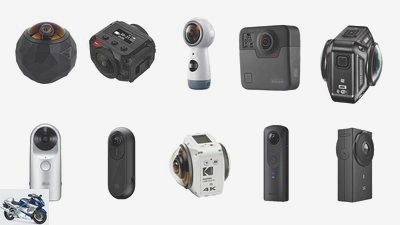
Photo: mps-Studio
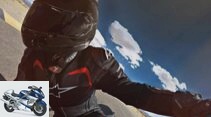
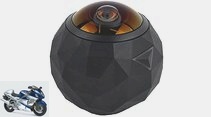
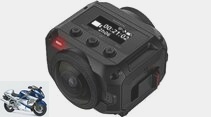
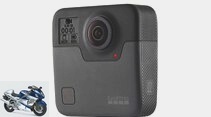
11 pictures
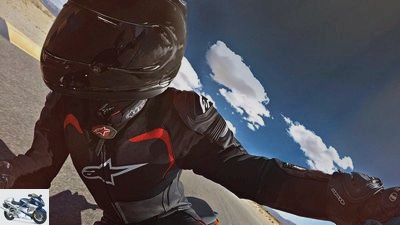
Alpinestars
1/11
Ten 360-degree cameras compete in a comparison test.
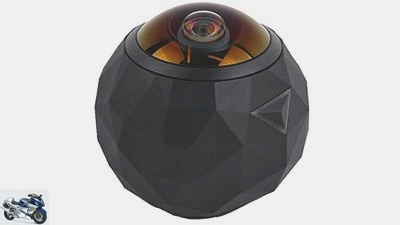
SYSTEM
2/11
Audiovox 360fly 4K.
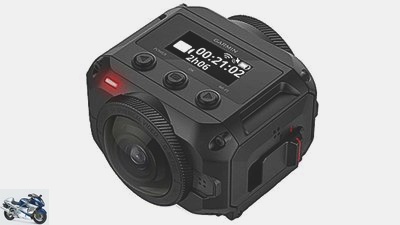
SYSTEM
3/11
Garmin Virb 360.
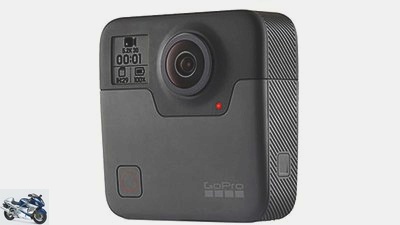
SYSTEM
4/11
GoPro Fusion.
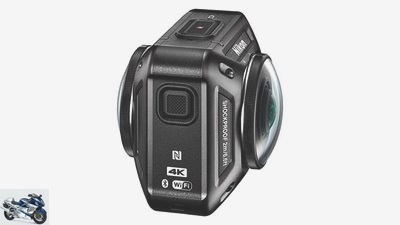
SYSTEM
5/11
Nikon Keymission 360.
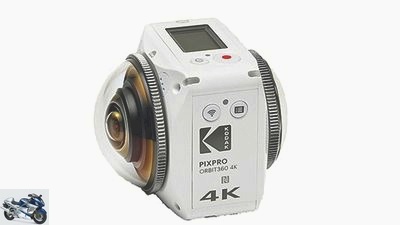
SYSTEM
6/11
Kodak PixPro 4KVR360.

SYSTEM
7/11
Samsung Gear 360 (2017)
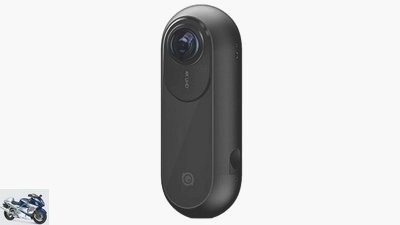
SYSTEM
8/11
Insta360 ONE.
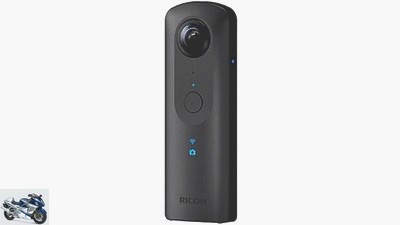
SYSTEM
9/11
Ricoh Theta V.
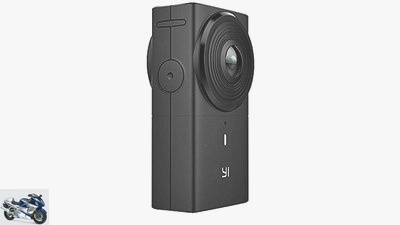
SYSTEM
10/11
YI Technology 360 VR.
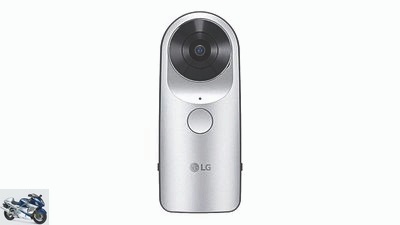
SYSTEM
11/11
LG 360 Cam.
accesories
360 degree cameras tested (2018)
360 degree cameras put to the test (2018)
GoPro, Garmin, Nikon and Co.
Filming forwards and backwards at the same time? Thanks to 360-degree cameras, this is no longer a problem. In order not to lose track of the very wide range of action cams on offer, we took ten candidates into the all-round view.
Roman Kirschbauer
11/23/2018
Action cams can capture extraordinary moments thanks to their small dimensions and countless mounting options. Up until now, however, you had to decide which motif should be captured from the moments that are always far too quickly fleeting: the endless view of a breathtaking landscape, the view of yourself, your buddies or, as usual, the speedometer and the course of the road? Why not just put the camera down somewhere and be able to decide afterwards what should be best seen in each moment? With the 360-degree cameras, this is actually possible. Thanks to ever more powerful processors, action cams can also record everything around them.
Buy complete article
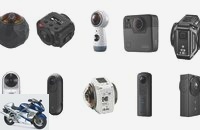
360 degree cameras tested (2018)
GoPro, Garmin, Nikon and Co.
5 pages) as PDF
€ 2.00
Buy now
The films can then be viewed in special players, on Facebook or YouTube and especially well on the smartphone. The section in the video also looks where the picture is dragged with the mouse or the cell phone is panned. The 3-D illusion becomes perfect with VR glasses, because then the image follows the head movement – and the viewer is right in the middle of the situation. The term for it is already on everyone’s lips: Virtual Reality – although strictly speaking that is not true, since the reality is only filmed and you can only interact with the view. This effect has been known for a long time from Google Streetview, for example, where you can go to many places in the world on the computer and look around. The production of such photos and films was previously very complex and expensive. But now they are affordable for everyone.
1st place: GoPro Fusion (test winner)
Website: www.gopro.com
Price (RRP): € 729.99
Max. Video resolution and FPS: 5.2K (4,992 x 2,496) 30p, 3K (2,880 x 1,620) 60p
Max. Photo resolution: 18 MP
File formats: MP4 (H.264), JPEG
Connections: USB-C 3.0
Storage: 2 microSD cards, at least Class 10 or UHS-I
Connectivity: GPS, Wi-Fi, bluetooth, compass, gyroscope
Sensors: Compass, gyroscope
Battery (recording time): up to 1.5 h, removable, 2620 mAh, lithium-ion
Waterproof: 5 m
Tripod connection: Action bracket made of full metal (removable)
Size: 74 x 74 x 36 mm
Weight: 225 g
Scope of delivery: Bag, USB-C cable, battery, 2 x adhesive mounts, Fusion-Grip mounts
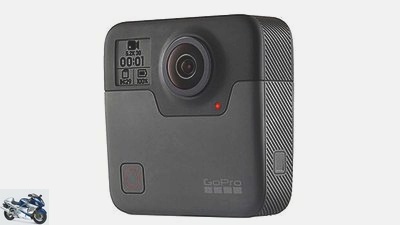
SYSTEM
GoPro Fusion
Video, photo and sound quality: sharpest picture in comparison, rich colors; Problems with colored gradients on contrasting edges; digital image stabilization; four microphones provide surround sound
360-degree processing and playback options: App with useful workflow, extensive processing options; Desktop program with plug-ins for Adobe After Effects and Premiere; Transmission to the PC is better via cable, as two memory cards
Usability: only two buttons, status display with many abbreviations, good automatic mode, clear app and desktop software
Processing / equipment: high-quality housing with non-slip rubber cover, waterproof up to 5 m, delivery with bag
Conclusion: The GoPro Fusion delivers the best image quality in the test and convinces with numerous features. The price is high, but definitely justified for the quality offered.
MOTORRAD verdict: very good
2nd place: Garmin Virb 360
Website: www.garmin.com
Price (RRP): € 799.99
Max. Video resolution and FPS: 5.7K / 30 FPS, 5K / 30 FPS, 4K / 30 FPS, 3K / 60 FPS
Max. Photo resolution: 15 MP
File formats: MP4 (AVC / H.264), JPEG
Connections: micro-USB 2.0, micro-HDMI
Storage: microSD card, at least UHS-I, class U3 or higher
Connectivity: GPS, GLONASS, Wi-Fi, Bluetooth 4.0, NFC, ANT+
Sensors: Barometer, accelerometer, gyroscope, compass
Battery (recording time): up to 1 h 5 min, removable, 1250 mAh, lithium-ion
Waterproof: 10 m
Tripod connection: Adapter plates on 1/4 “thread and on action bracket
Size: 39 x 59.3 x 69.8 mm
Weight: 160 g
Scope of delivery: Battery, USB sync cable, tripod holder, adapter plates for holder, table tripod / handle
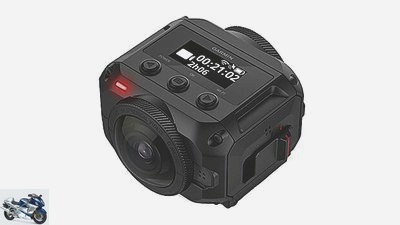
SYSTEM
Garmin Virb 360.
Video, photo and sound quality: good image quality with largely sharp images, slight sharpness noise; very neutral color rendering; Sound is full and clear, adapts to the view
360-degree processing and playback options: up to 5K the Virb can calculate the images in the camera, at 5.7K they are stored raw on the card; free desktop app; large distance between the lenses causes stitching errors in nearby objects
Usability: large slide on the side, top screen, easy to read, great menu navigation, intuitive voice control, app and software versatile
Processing / equipment: Robust housing, waterproof up to 10 m without an additional protective cover, many sensors for a.o. the height
Conclusion: The Virb 360 offers excellent recording quality and many useful features, such as height, speed and g-meters. The price is high, but it corresponds to the quality.
MOTORRAD verdict: very good
3rd place: YI Technology 360 VR (purchase tip)
Website: www.yitechnology.com
Price (RRP): € 399.99
Max. Video resolution and FPS: 5.7K (5,760 x 2,880) 30p, 1,920 x 960, 120p
Max. Photo resolution: 16.6 MP
File formats: MP4 (H.264), JPEG
Connections: USB-C, Micro-HDMI
Storage: microSD card class U3 or higher
Connectivity: Wi-Fi, bluetooth
Sensors: no
Battery (recording time): 1 h, removable, 1,430 mAh
Waterproof: no
Tripod connection: 1/4 “
Size: 102 x 53 x 30 mm
Weight: 170 g
Scope of delivery: Camera, USB cable, leather case, mini tripod, battery
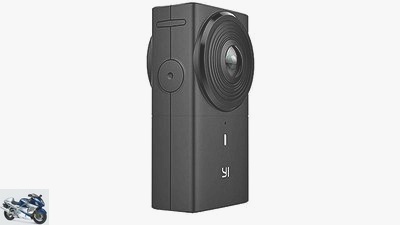
SYSTEM
YI Technology 360 VR.
Video, photo and sound quality: decent photo and video quality, slight waste at the edges, natural color reproduction; good results in difficult lighting conditions; very good image stabilization after update, sound is usable
360-degree processing and playback options: Mobile workflow with moderate stitching results, in-camera stitching up to 4K, mobile app for iOS and Android with fast connection for remote control, 4K live streaming possible, desktop app so far only available for Windows and cumbersome without instructions
Usability: Operation via three buttons, small display with a good menu structure and understandable terms (in German), modes for automatic and manual, easy to control via the app
Processing / equipment: Housing made of plastic not of high quality, not waterproof, currently no waterproof cover and hardly any mounting accessories available
Conclusion: The YI 360 VR from China can more than keep up in terms of image quality. The operation is simple, only the workflow on the computer and the haptic impression could be better. The price is reasonable.
MOTORRAD verdict: Good
4th place: Ricoh Theta V
Website: www.theta360.com
Price (RRP): € 449.00
Max. Video resolution and FPS: 4K (3840 x 1920) 30p
Max. Photo resolution: 14.5 MP
File formats: MP4 (H.264), JPEG
Connections: micro-USB 2.0, 3.5 mm jack
Storage: 19 GB internal storage
Connectivity: Wi-Fi, bluetooth
Sensors: no
Battery (recording time): 1 h 5 min, permanently installed, lithium-ion
Waterproof: only with optional housing
Tripod connection: 1/4 “
Size: 45 x 130 x 23 mm
Weight: 121 g
Scope of delivery: USB cable, bag, instructions

SYSTEM
Ricoh Theta V.
Video, photo and sound quality: good video and photo quality; Resolution and sharpness sufficient for panorama view; disturbing color fringes and contrasting edges in the border area; great stitching
360-degree processing and playback options: Videos are stored raw on the camera, can be merged in the desktop and smartphone app; The former is functional, the mobile app still has deficits with 4K, with Full HD it works well
Usability: simple, understandable operation, detailed settings can be handled via smartphone app, no problems connecting
Processing / equipment: handy and light, less action cam than a practical and small 360-degree camera
Conclusion: The Theta is a consistently solid cam, but it doesn’t fully realize its potential. The mobile workflow could be better, and in-camera stitching would be nice too.
MOTORRAD verdict: Good
5th place: Audiovox 360fly 4K
Website: www.360fly.com
Price (RRP): € 549.00
Max. Video resolution and FPS: 2,880 x 2,880 30p
Max. Photo resolution: k. A..
File formats: MP4 (H.264)
Connections: Mini-USB via charging station
Storage: 64 GB internal memory, not expandable
Connectivity: Wi-Fi, bluetooth
Sensors: Accelerometer, compass, GPS, gyroscope
Battery (recording time): 1.5 h, permanently installed, 1,780 mAh lithium polymer
Waterproof: 10 m
Tripod connection: 1/4 “
Size: 61 mm
Weight: 172 g
Scope of delivery: Camera, bag, action cam adapter, charging station, USB cable
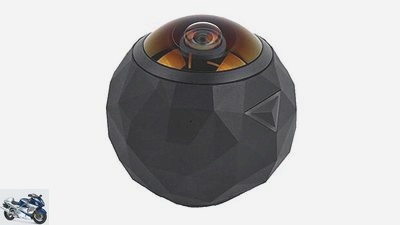
SYSTEM
Audiovox 360fly 4K.
Video, photo and sound quality: good resolution, but lack of sharpness; poor light-dark contrast ratio, no structure in both directions; Sound is recorded in stereo, but sounds very dull
360-degree processing and playback options: no stitching necessary due to the single lens concept, but there is a blind spot behind the camera that is annoying in VR mode; rather a compromise between normal and 360-degree cameras; iOS and Android app as well as simple, free, intuitive desktop software
Usability: Only one button to switch on / off and start recording, pressing the button is acknowledged by vibration, the camera lights up in different colors depending on the status
Processing / equipment: robust, dust and shock resistant, waterproof up to 10 m, internal memory of 64 GB sufficient, but not expandable
Conclusion: Image and sound quality of the 360FLY are not first class, but if you can live with the blind spot, you get a robust and high-quality action camera with first-class battery life.
MOTORRAD verdict: Good
5th place: Insta360 ONE
Website: www.insta360.com
Price (RRP): € 359.00
Max. Video resolution and FPS: 4K (3840 x 1920) 30p, 2560 x 1280 60p, 2048 x 512 120p
Max. Photo resolution: 24 MP
File formats: insv, MP4, LOG insp, JPEG, RAW
Connections: Apple Lightning / USB-C / Micro-USB
Storage: microSD card
Connectivity: Bluetooth
Sensors: 6-axis gyroscope for image stabilization
Battery (recording time): 1 h 10 min, permanently installed, 820 mAh
Waterproof: no
Tripod connection: 1/4 “
Size: 69 x 36.5 x 25 mm
Weight: 82 g
Scope of delivery: Camera, bag, USB cable, 2 tripod adapters, 8 GB MicroSD card
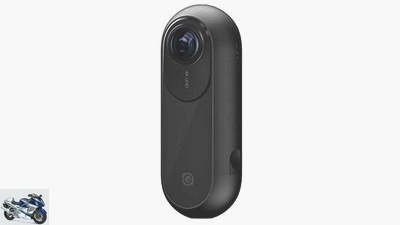
SYSTEM
Insta360 ONE.
Video, photo and sound quality: Strong noise suppression is necessary even in normal lighting conditions, leading to a loss of detail. Contrasts medium-class, picture partly dark; very good 6-axis image stabilization; Sound recording in mono only
360-degree processing and playback options: Stitching via smartphone app is okay, better via desktop, but still not a perfect result; innovative functions such as free capture
(creates video with object tracking) or Bullet Time (high-speed recording of the camera flying around); Post-processing on the PC cumbersome
Usability: Designed to be plugged into smartphones (iPhone and Android), also functions independently of it, remote activation via Bluetooth, powerful smartphone app
Processing / equipment: high-quality workmanship, compact design, few mounting accessories, the supplied memory card could be larger
Conclusion: The ONE concept combines interesting features with simple operation and versatile mobile processing options. But the image quality is only good for the smartphone.
MOTORRAD verdict: Good
7th place: Nikon Keymission 360
Website: www.nikon.de
Price (RRP): € 349.00
Max. Video resolution and FPS: 4K (3840 x 2160) 24p, FHD (1920 x 1080) 24 / 25p
Max. Photo resolution: 30 MP
File formats: MP4 (H.264 / AVC), JPEG
Connections: micro-USB 2.0, micro-HDMI
Storage: microSD card
Connectivity: Wi-Fi, NFC, Bluetooth 4.1
Sensors: no
Battery (recording time): up to 1 h 10 min, removable, 1050 mAh, lithium-ion
Waterproof: 30 m
Tripod connection: 1/4 “
Size: 61 x 66 x 60 mm
Weight: 199 g
Scope of delivery: Mains adapter, battery, USB cable, adapter socket, lens protector, underwater lens protector, silicone coating

SYSTEM
Nikon Keymission 360.
Video, photo and sound quality: Videos and photos lack sharpness, details are difficult to see, colors are oversaturated; no horizon adjustment; tinny clay; Highest resolution photos
360-degree processing and playback options: Stitching in the camera with medium results, transitions visible through hard edges of color and brightness; Fixing must be considered, as there is no horizon compensation; App with a limited range of functions, is also unstable
Usability: two buttons, no display; Settings only sensibly possible via app, connection with app and remote control not intuitive
Processing / equipment: high-quality magnesium housing, waterproof up to 30 m without an additional cover, lots of accessories
Conclusion: The Nikon Keymission 360 has been technically overtaken by the competition, but still delivers a very solid performance at a fairly fair price.
MOTORRAD verdict: satisfying
8th place: Samsung Gear 360 (2017)
Website: www.samsung.com
Price (RRP): € 249.00
Max. Video resolution and FPS: 4K (4096 x 2048) 24p
Max. Photo resolution: 15 MP
File formats: MP4 (H.265)
Connections: USB-C
Storage: microSD card
Connectivity: Wi-Fi, bluetooth
Sensors: no
Battery (recording time): 2 h 10 min, permanently installed, 1,160 mAh
Waterproof: no
Tripod connection: 1/4 “
Size: 101 x 46 x 45 mm
Weight: 130 g
Scope of delivery: Camera, bag, USB cable, USB charger, wrist strap with camera support ring
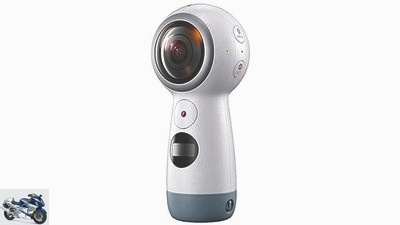
SYSTEM
Samsung Gear 360.
Video, photo and sound quality: Overall, the pictures are usable, sharpness and contrast could be better; no image stabilization; Resolution of the photos too low; Sound good for ambient noise, but too susceptible to wind noise
360-degree processing and playback options: Storage of both video halves in one file with two circular image / video parts; Playout from the software only possible directly to YouTube, Facebook or SamsungVR. Live streaming directly from the camera (up to 2K resolution) to YouTube or Facebook is possible
Usability: intuitive operation using three buttons and a status screen, also possible without a smartphone; App makes it even more convenient to use
Processing / equipment: high quality, lies comfortably in the hand, wrist strap with rubber ring that serves as a stand; Accessories from third party suppliers, battery not replaceable
Conclusion: The Gear 360 is well suited for quick handheld filming and for sharing on Facebook and YouTube. Nevertheless, the picture is not outstanding, which limits the further processing options.
MOTORRAD verdict: satisfying
9th place: Kodak PixPro 4KVR360
Website: www.kodakpixpro.com
Price (RRP): € 499.99
Max. Video resolution and FPS: 4K (3840 x 2160) 30p, FHD (1920 x 1080) 60p
Max. Photo resolution: 21 MP
File formats: MP4 (H.264), JPEG
Connections: micro-USB 2.0, mico-HDMI
Storage: microSD card
Connectivity: Wi-Fi, Bluetooth 4.1, NFC
Sensors: no
Battery (recording time): 55 min, removable, 1,260 mAh lithium-ion
Waterproof: jet-proof (IPX5)
Tripod connection: 1/4 “
Size: 56 x 56 x 76 mm
Weight: 157 g
Scope of delivery: Battery, charger, USB cable, power supply unit, protective cover, three-legged tripod, lens protector, carrying case, cleaning cloth
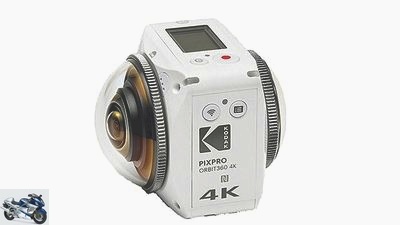
SYSTEM
Kodak PixPro 4KVR360.
Video, photo and sound quality: Inhomogeneous image quality due to different image angles of the lenses, disturbing color fringes on contrasting edges; no image stabilization, image alignment missing; Sound in stereo usable
360-degree processing and playback options: 4K merged directly from the camera only 15 fps, externally a maximum of 24 fps; Due to the different lens angles, the selfie stick cannot disappear in the stitching area; cumbersome, not very versatile desktop software
Usability: Menu navigation not intuitive, screen symbols difficult to see, initial camera setup cumbersome, app and Bluetooth pairing complicated
Processing / equipment: stable and high quality, replaceable lens protector, splash-proof, optional underwater housing
Conclusion: As a 3-in-1 cam, the PixPro is robust and practical, but with uneven image quality and a poor, because not intuitive, operating concept. The stable workmanship is convincing.
MOTORRAD verdict: satisfying
10th place: LG 360 Cam
Website: www.lg.com
Price (RRP): € 199.99
Max. Video resolution and FPS: 2K (2,560 x 1,280) 30p
Max. Photo resolution: 16 MP
File formats: MP4 (MPEG4 / H.264)
Connections: USB-C
Storage: 4 GB + microSD card
Connectivity: Wi-Fi, bluetooth
Sensors: Accelerometer, compass, gyroscope
Battery (recording time): 1 h 10 min, permanently installed, 1,200 mAh
Waterproof: no
Tripod connection: 1/4 “
Size: 97 x 30 x 25 mm
Weight: 73 g
Scope of delivery: Camera, protective cap, USB cable
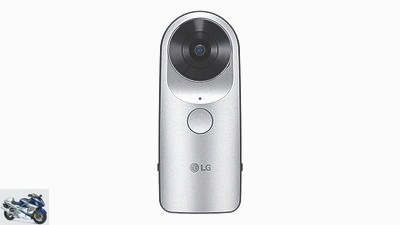
SYSTEM
LG 360 Cam.
Video, photo and sound quality: too low resolution, videos and pictures pixelated and blurred; neutral color reproduction, dark areas can hardly be reproduced; Noise at the edges even in normal lighting conditions
360-degree processing and playback options: Stitching only in the desktop app, the result is only satisfactory, as indicated by light stripes in the image and clear blurring; Desktop software offers zoom and movable (Google Streetview) previews and upload options to YouTube and Facebook
Usability: easy handling using two buttons, remote control via smartphone app, with preview and manual image setting options, cumbersome connection
Processing / equipment: high-quality appearance, a bit slippery in the hand without an additional handle, hardly any accessories, battery not replaceable
Conclusion: The LG is good for creating a 360-degree video quickly by hand. However, the resolution is too low for a good film quality. The performance goes in the face
of the fight price in order.
MOTORRAD verdict: sufficient
Final ranking: GoPro wins the comparison test
The price difference between the most expensive and the cheapest 360-degree camera is a lush 600 euros. But the differences in the price level can also be found to a large extent in the scope of services and the quality offered. Especially the GoPro that Garmin and with slight cutbacks the YI Technology deliver excellent results. When installed correctly, these cameras can be used to take pictures of driving a motorcycle, which can later be reproduced very realistically on a smartphone or with VR glasses.
The power of the two lenses
Until not so long ago, a 360-degree recording was only possible with a kind of cube holder, into which six individual cameras were inserted, each of which was filming in a different direction. So you could generate a calculated panoramic video. The fully spherical mini cameras developed in the last year and a half work predominantly with two lenses and two image sensors, so they are two cameras in one housing. The optics are curved so that they each capture an angle of 180 degrees. In order to turn the video halves generated from them into a displayable video, they have to be converted into the equirectangular projection. The two 180-degree individual images are combined to form a 360-degree all-round image. The technical term for this is stitching. The whole thing then results in a picture ball, which now has to be rolled out, similar to converting a globe into a world map. Of course, both require a lot of computing power.
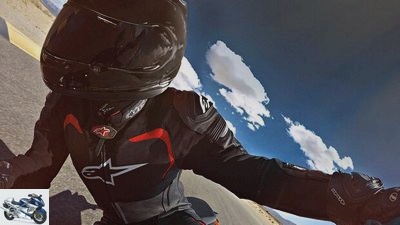
Alpinestars
The action cam should also be secured on the racetrack.
However, some manufacturers such as GoPro, Garmin or Nikon have even managed to integrate this process into the camera, so that you can get a finished 360-degree video with quite good results directly from the memory card. Almost all VR cameras in the test field advertise with at least a 4K video resolution (i.e. 3,840 pixels on one line). When looking at the material on a larger screen than the smartphone, however, it quickly becomes apparent that it does not look ultra-high-resolution. This is simply due to the fact that a section of the 4K video material is zoomed in for the panoramic view. The full resolution is only shown when you zoom out, but the extreme fish-eye of the lenses also becomes visible, which ensures the large recording angle. This in turn leads to the “Little Planet” effect, ie an overemphasis on the edges. For panorama videos, 4K should be the lower limit and the viewing window should not be too large. Less resolution is neither fun nor useful for this purpose. Therefore, the test winners from GoPro, Garmin and also the Yi can record up to 5.2K and 5.7K respectively. But: More resolution inevitably leads to more data, and so the files are quite large – with corresponding demands on the computing power.
Quality has its price
The ten models we tested hardly differ from conventional action cams in terms of operation and mounting. However, it should be noted that the brackets have to withstand more due to the slightly larger weight. If you decide to buy a 360-degree camera, you should think in advance what you want to do with the videos: Is it enough to show them on your smartphone, or should they also have one on the monitor or in the VR glasses cut a good figure? The highest quality has its price. The GoPro Fusion and the Garmin Virb 360 clearly lead the field and also cut a good figure in the large screen. If, on the other hand, you only want to create a few wow effects for your smartphone and social media, you can confidently choose a cheaper model.
A new way of filming
In fact, buying a 360-degree camera is not enough. You also have to get involved with the associated way of working. The all-round view offers great opportunities to act as a director afterwards. But if you want to shoot a spherical video instead of a simple camera that only films a certain section, there are a few special features to consider. Three tips:
1. Define central objects
Even if the camera records everything around, important objects or people should be in the direct field of view of one of the two lenses. The transition between the front and rear cameras, the stitching area, can almost always be seen. Jerky transitions of color and brightness as well as blurred edges characterize it. In addition, objects that are in this area are distorted. This is due to the fact that the two individual images cannot be brought together completely seamlessly, they overlap a little. During installation, the camera should be aligned in such a way that no important objects appear in this area. The stitching area can also be used cleverly: if you position the bracket directly under the camera, they almost disappear and the camera appears to float.
2. The camera is the person
This rule also applies to normal filmmaking, but it is even more important with this type of video. The lens should be treated as a person’s face and positioned at eye level. Otherwise the more or less desired effect can quickly occur, the observer is a dwarf or a giant. In addition, rotations or inclinations as well as artificial movement of the camera itself should be avoided. This creates an uncomfortable feeling for the viewer and also superimposes the viewing angle chosen by them. Movements should take place in a familiar frame of reference, just like when the viewer is sitting on a motorcycle.
3. The viewer needs time to orientate himself
When you come to a place for the first time, you need a brief moment to look around and orientate yourself. It is the same in 360-degree filming. Fast movements, changes of location and many cuts have a disorienting and confusing effect. Hard cuts are still no problem. Their frequency should just be reduced.
Prohibited on the racetrack due to safety
The great availability and popularity of action cams in general meanwhile has consequences not only in public traffic. Racetrack operators and race organizers are also forced to regulate their use due to incidents and falls caused by action cams falling from a motorcycle or helmet. A part allows their use only if the camera is also secured to the bike. Which doesn’t just mean a bit of duct tape. By the way, a flying action cam is not automatically called a drone.
Related articles
-
Dentges 34 pictures Dentges 1/34 You have found your way into the middle of society. The fun society. And they are particularly popular with everyone who…
-
BILLION accesories Product test: onboard cameras Product test: onboard cameras Seven current helmet cameras in the test Motorcycling is action. A hot…
-
Ten motorcycle helmets with Bluetooth in the test (2018)
mps studio 39 pictures mps photo studio 1/39 BMW System 7 carbon. mps photo studio 2/39 Backlight: While the sun visor is a little tight, the wind…
-
Breakable clothing Boots Motocross boots tested Product test enduro boots Nine motocross boots tested Eating kilometers on the autobahn, fun bends on…
-
Thorsten Dentges 25th pictures Thorsten Dentges 1/25 They are supposed to protect. Against airflow, UV radiation, flying insects and dangerous gravel…
-
26 motorcycle locks tested (2016)
Dentges 38 pictures Dentges 1/38 MOTORRAD took 26 locks to the A. Wendt company in Bergheim (www.zieh-fix.com). Company founder Adalbert Wendt (2nd from…
-
Meyer, BILLION 44 pictures mps 1/44 Many heads, one opinion: fitting problems usually run through many sizes. mps 2/44 Conclusion on the IXS HX 510: A…
-
Motorbike gearshifts for the race track being tested
fact accesories Motorbike gearshifts for the racetrack being tested Product test: automatic switchgear Shift at full throttle and save tenths of a second…
-
Smartphone, mobile phone, GPS mount motorcycle 2018 test
Photo: Thorsten Dentges 28 pictures Dentges, mps photo studio 1/28 6 smartphone and GPS mounts tested. Dentges, mps photo studio 2/28 Cellularline Uni…
-
Tested wax jackets for motorcyclists
mps photo studio clothing Station wagons, jackets & pants Tested wax jackets for motorcyclists Motorcycle jackets with style Tested wax jackets for…